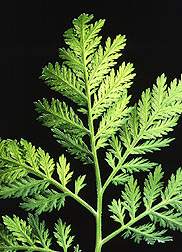This page has been archived and is being provided for reference purposes only. The page is no longer being updated, and therefore, links on the page may be invalid.
Ancient Healing Compounds May Get Boost from Modern ScienceBy Jill LeeApril 27, 1998 Ancient medical texts as old as 4,000 years old talk about healing herbs. Today, scientists at the Agricultural Research Service are finding better ways to mine these ancient plants, like St. Johns wort and wormwood, for their curing compounds and for safer natural pesticides. ARS recently established a Natural Products Utilization Research Unit, based in Oxford, Miss. Among the research team’s successes are improved extraction techniques for annual wormwood plant to obtain artemisinin, a potent malaria-fighting drug. The Oxford ARS team also is improving extraction techniques for St. John’s wort. This plant yields mood-enhancing compounds, according to studies published in medical journals. The team finds better extraction methods by studying plant physiology. In the case of wormwood, published research had described tiny balloon-like glands on the plant’s leaves. The ARS team led by chemist Steve Duke found that the glands are filled with artemisinin, the malaria-fighting compound. In nature, the glands serve as a built-in biopesticide applicator. When the glands rupture during insect attacks, they ooze micro-doses of artemisinin and other compounds, repelling the pests. In studies with St. Johns wort, the scientists are improving extraction methods for hypericin, which many scientists believe is responsible for the plant’s benefits. Processing companies’ usual approach is to crush the plant, but ARS research suggests this releases enzymes that can destroy the hypericin. A feature story on the research appears in the April issue of Agricultural Research magazine, the monthly publication of the Agricultural Research Service. The story can be viewed on the World Wide Web at: /is/AR/archive/apr98/drug0498.htm Scientific contact: Steve Duke, ARS Natural Products Utilization Research Unit, located at the National Center for the Development of Natural Products at the University of Mississippi, Oxford, Miss., phone (601) 232-1036, fax (601) 232-7062, sduke@ag.gov. |

